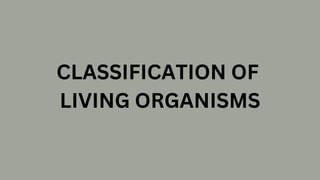
Animal Kingdom Classification.pdf
- 2. FAMILIES GENUS SPECIES PHYLUM CLASSES ORDERS HIERARCHY SCALE OF CLASSIFICATION KINGDOM
- 3. KINGDOMS: PROKARYOTE - bacteria PROTISTA - a collection of single-celled organisms and some simple multicellular ones such as seaweeds. FUNGI - mushrooms, toadstools and mucus. PLANTAE- includes all plants. ANIMALIA - classified based on cell structure, mode of nutrition, mode of reproduction and body organization. Multicellular, which includes "you" 1. 2. 3. 4. 5.
- 4. PHYLUM: PORIFERA - marine animals that consists of sponges, filled with pores. 1. 2. CNIDARIA - marine mammals, but not the spongey kind. The phylum is further classified into some groups: Anthozoa, Scyphozoa, Hydrozoa, Cubazoa, etc. Examples of cnidarians are corals, jellyfish, and anemones.
- 5. PHYLUM: 3. MOLLUSCA- Common examples are clams, snails, and mussels. 4. ARTHROPODA- Arthropods are characterized by exoskeletons and bodies divided into segments. Common examples are scorpions, shrimp, and butterflies.
- 6. PHYLUM: 5. CHORDATA- Chordates have a single, tubular nerve cord that runs along the back (dorsal) surface of the animal which, in most species, forms a brain at the front (anterior) end of the animals. 6. ANNELIDA- Segmented worms with multiple circular segments.
- 7. 7. ECHINODERMATA- Radially symmetrical animals with spiny skin. one of their unique characteristics is they don’t have brains. Instead, they have nerves running through their body from their mouths. Depending on the species, they also have different features for finding food, including eyespots at the end of their arms that detect light or tube feet that smell food. Example starfish, sea urchin, leopard sea cucumber. PHYLUM:
- 8. CLASSES: AGNATHA - This class is composed of "jawless fish", all of which are vertebrates. Example hag fishes and lampreys. 1. 2. CHRONDICHTYES - The Chondrichthyes are opposed to the agnatha class in that the members "have jaws".
- 9. CLASSES: 3. Osteichthyes - They have bones rather than cartilage. This class contains most fish at sea. 4. Aves - class of birds, warm-blooded vertebrates with pairs of wings and skin made of feathers. They also have beaks (no teeth), a strong skeletal system, and the ability to lay eggs.
- 10. CLASSES: 5. Reptilia - are characterized by scaly skins, and they could either have limbs or crawl on their stomach. They are all vertebrates and have close ties with birds. Examples of reptiles still existing today are lizards, snakes, crocodiles, and turtles 7. Mammalia - are characterized by the presence of the mammary gland in females. 6. Amphibia - are described as tetrapods and ectothermic, which simply means they move on four limbs and rely on the environment to generate heat. Examples are frogs, salamanders, and toads.
- 11. ORDER: CARNIVORA - eats mainly meat, just as the name implies. However, some of them are omnivores and even herbivores. Examples are bears, dogs, and cats. 1. 2. RODENTIA - Rodents are usually small mammals that are characterized by long tails, a single pair of incisors on the upper and lower jaw, and skin made of fur. Examples are rats and rabbits.
- 12. ORDER: 3. CHIROPTERA - holds the record of being the only mammal that has wings and can fly. The only example of the Chiroptera is the different bat species. 4. PRIMATES - diverse order, divided into 3 groups. We have the strepsirrhines, the haplorhines, and the simians. They are characterized by large brains, color vision, and a big reliance on sight. Examples are lemurs, monkeys, and apes.
- 13. ORDER: 5. CETACEA consists of aquatic mammals, and their biggest trait is the ability to survive underwater. They have a body shape that enables them to adapt to the underwater and a high level of intelligence. Ex. different whale species we have.
- 14. ORDER: 6. ARTIODACTYLA Also called even-toed ungulates, these animals bear weight equally on two of their five toes. Examples of both orders are the Indian rhinoceros, the Brazilian tapir, the American bison, and the giraffe.
- 15. ORDER: 6. BLATTODEA Blattodea is an order of insects that contains cockroaches and termites. Formerly, termites were considered a separate order, Isoptera, but genetic and molecular evidence suggests they evolved from within the cockroach lineage, cladistically making them cockroaches as well.
- 16. FAMILIES CARNIVORA Felidae (cats) Canidae (dogs) Ursidae (bears Mustelidae (weasels) 1.
- 17. FAMILIES Lemuridae (Lemurs) Cebidae (New World Monkeys) Tarsiidae (Tarsiers) Pongidae (Apes) Hylobatidae (Gibbons) 2. PRIMATES
- 18. Anomaluridae Pedetidae Castoridae Geomyidae 3. RODENTS - which are characterized by a single pair of continuously growing incisors in each of the upper and lower jaws. FAMILIES
- 19. Felis (domestic cats) Puma (panthers and jaguars) Panthera (Tigers, leopards, jaguars) Felidae family (cat) - patterned fur, comparatively short limbs with soft pads on the feet, usually sharp curved retractile claws, a broad rounded head with short but powerful jaws equipped with teeth suited to grasping, tearing, and shearing through flesh, erect ears, and typically eyes with narrow or elliptical pupils and especially adapted for seeing in dim light GENUS
- 20. Canis (Coyotes, jackals) Atelocynus (short-eared dog) Cerdocyon (crab-eating fox) Canidae family (dog) - Canines tend to be slender and long-legged, with a long muzzle, bushy tail, erect pointed ears, and well-developed canine and cheek teeth. They prey on all types of animals; some also eat carrion and vegetable matter. They probably were the first animals to be domesticated. GENUS
- 21. Red fox (Vulpes vulpes) Brown recluse (Loxosceles reclusa) Grizzly bear (Ursus arctos horribilis) SPECIES
- 22. EXAMPLE Kingdom: Animalia Phylum: Chordata Subphylum: Vertebrata Class: Mammalia Order: Carnivora Family: Felidae Genus: Felis Species: catus
- 23. EXAMPLE Kingdom: Animalia Phylum: Chordata Class: Mammalia Order: Carnivora Family: Canidae Genus: Vulpes Species: vulpes Red Fox
- 24. RULES IN WRITING SCIENTIFIC NAMES Capitalize only the genus name. The species designation is always lowercased. The first word identifies the genus and the second word identifies the species. Both the words in a scientific name are especially underlined or printed in italics.